|
Sunday, May 7 – Marrakesh
After breakfast, we meet our local guide to explore Marrakesh. Of course, Nour is always there with a big smile.
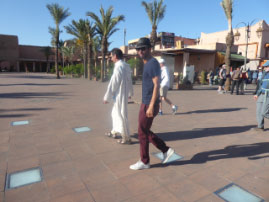
Marrakesh |
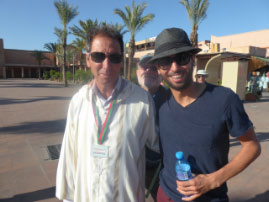
Marrakesh |
Our guide brings us into the Mellah (Jewish area). We stop at the Lazama Synagogue – one of the few visible remnants left of the Jewish community. The synagogue was established in 1492 – the same year C. Columbus sailed the ocean blue. The synagogue wasn’t open yet, so we continue down the alleyways, watching several shops opening up with interesting stuff to buy, like carpets, spices and anything else you can think of. We see a vendor hanging out a Berber carpet. In no time, the walls will hold hundreds of carpets for sale.
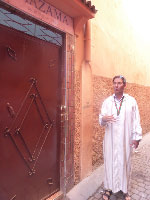
Marrakesh |
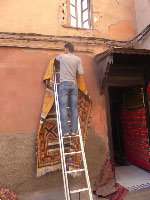
Marrakesh |
We walk to the opulent Palais Bahia (or Bahia Palace). “Bahia” means brilliance in Arabic. We arrive just in time to beat the crowds gathering in line.
The palace was built between 1866 and 1867 for Si Moussa, Grand Vizier of the Sultan. It occupies over two acres in the middle of Marrakech and has 150 rooms, including a Court of Honour, huge gardens and numerous open courtyards plus a harem that is off limits to visitors. Decorated in elegant Moroccan style, the interior has impressive fireplaces, mosaic flooring and painted cedar work.
Si Moussa’s son, Bou Ahmed, lived in the palace after his father died. The son brought with him four wives and several concubines. Following Bou Ahmed’s death in 1900, the palace was ransacked and all the valuables taken. The French arrived in the early 1900s and took over the palace for their Resident General.
We roam from room to room trying to avoid a rather loud Japanese group. We managed to get lost – I meant really lost, but found our way out and joined the group, just as they were leaving.
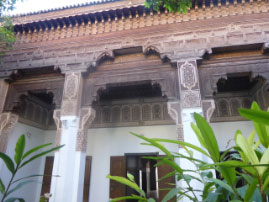
Palais Bahia |
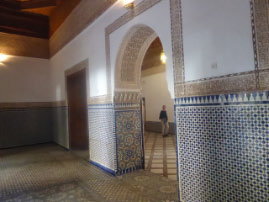
Palais Bahia |
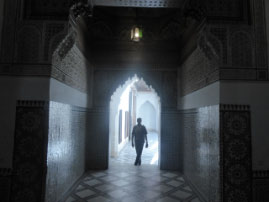
Palais Bahia |
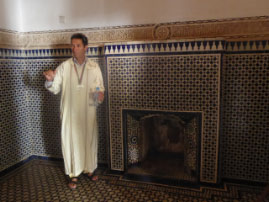
Palais Bahia |
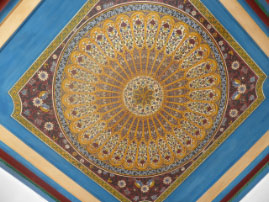
Palais Bahia |
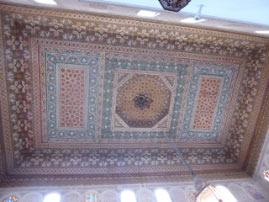
Palais Bahia |
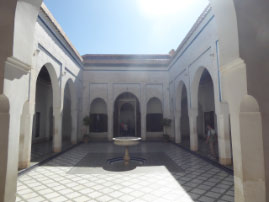
Palais Bahia |
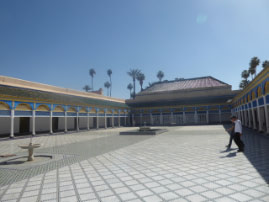
Palais Bahia |
We emerge from the Bahia Palace. Right across the street, we see a line of traditional horse-drawn carriages waiting to take us on the rest of tour. We hop in with Bob and Joan. What a hoot exploring Marrakech’s narrow alleyways, marketplaces, gardens mosques, and palaces in a carriage with the fringe on the top. (OAT always has fun surprises along the way.)
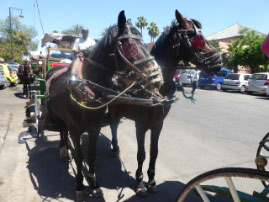
Carriage ride through Marrakech |
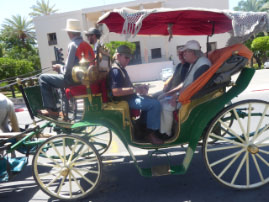
Carriage ride through Marrakech |
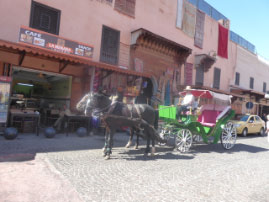
Carriage ride through Marrakech |
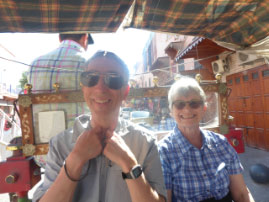
Carriage ride through Marrakech |
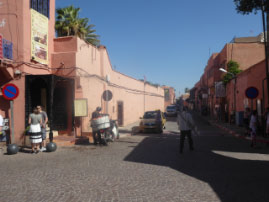
Carriage ride through Marrakech |
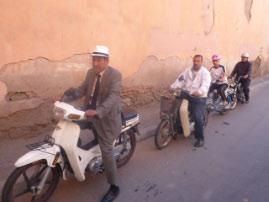
Carriage ride through Marrakech |
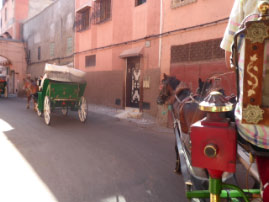
Carriage ride through Marrakech |
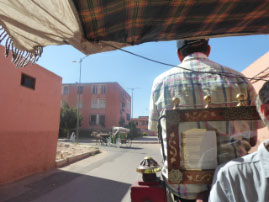
Carriage ride through Marrakech |
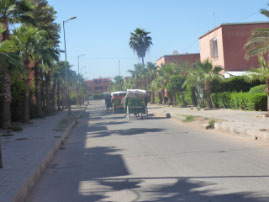
Carriage ride through Marrakech |
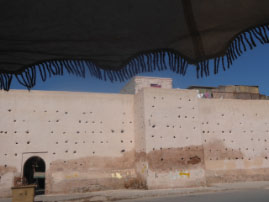
Carriage ride through Marrakech |
On the outskirts of the southern Medina, we pass by a large well-manicured garden right next door to the Royal Palace of Marrakech. The reddish pink palace dates back to the 12th century. Like the other 20 plus royal palaces in Morocco, visitors are not allowed to go in, so we strain our eyes to get a view of the guards in front of the gargantuan wooden gates.
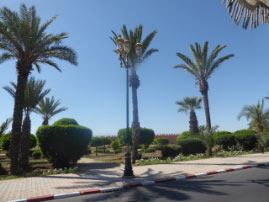
Marrakesh |
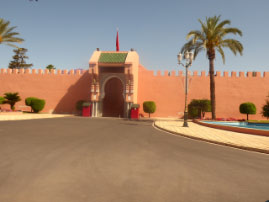
Royal Palace of Marrakech |
We park outside the Kasbah Mosque and Nour leads us down the narrow passage way to the Saadian Tombs. The high-walled compound is the final resting place of the Saâdian dynasty's sultans, princes, and other members of the royal household. It was established in the late 1500s by Sultan Ahmed el Mansour, who rests here now (hopefully in peace). Over 50 members of the Saadian Dynastic royalty are buried in the mausoleums. About 100 of the royalty’s favorite servants and soldiers are buried in tombs in the attractive palm tree shaded gardens.
I am surprised at how beautiful the place is. My favorite mausoleum room contains the sultan's grandson Ahmad al-Mansur’s tomb -- an ornate room with marble columns rising up to the ceiling.
The whole compound was sealed off when Sultan Moulay Ismail took control of Morocco. (Remember, Ismail is the ruthless leader who liked horses and fathered about a 1,000 children.) Strange that he didn’t destroy the tombs because his style was to destroy everything in sight.
The tombs weren’t rediscovered until 1917 when a French resident general noticed the tomb formations on an aerial survey map with a passageway from the side of the adjoining mosque. The tombs were in a fairly good state and have been beautifully restored. Amazing how these were hidden for so long.
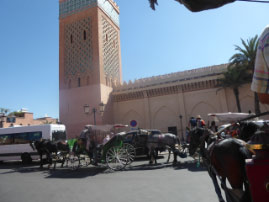
Kasbah Mosque |
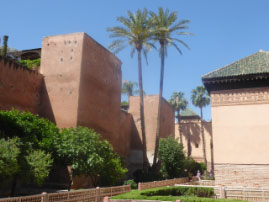
Kasbah Mosque |
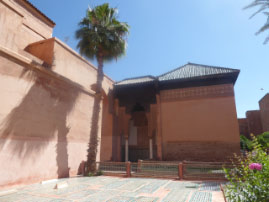
Saadian Tombs |
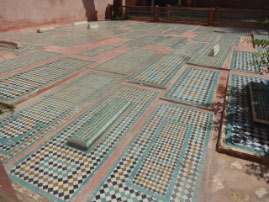
Saadian Tombs |
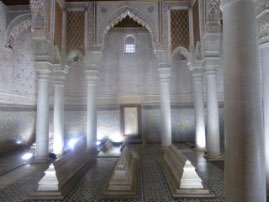
Saadian Tombs |
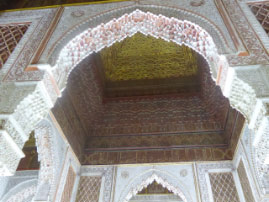
Saadian Tombs |
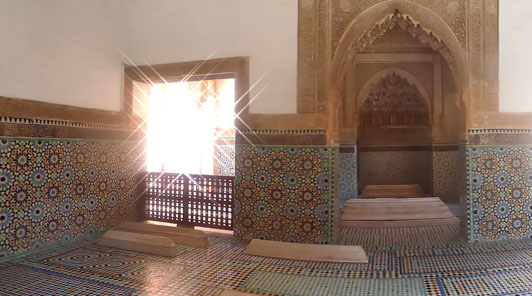
Saadian Tombs |
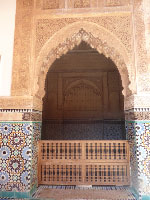
Saadian Tombs |
We stop for tea in a lovely, quiet place. The trinkets on sale at the café are reasonable and “speak to me.” However, it’s just stuff so I take only a photo and leave the stuff. Lord knows, I have plenty of stuff!
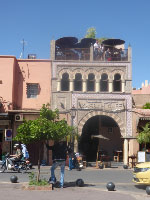
Marrakesh |
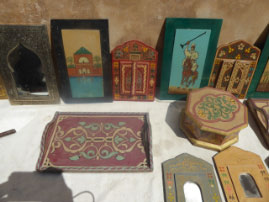
Marrakesh |
We walk a few blocks back to our horse drawn carriages. Back in the buggy again, we trot off to see more of this exotic city.
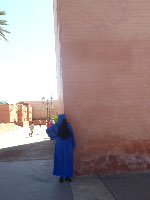
Marrakesh |
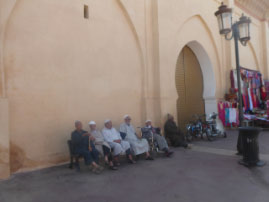
Marrakesh |
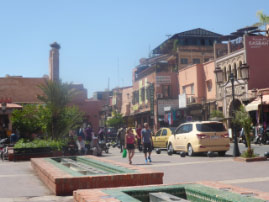
Marrakesh |
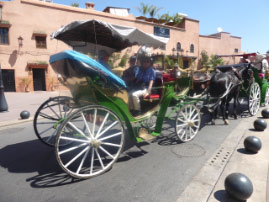
Marrakesh |
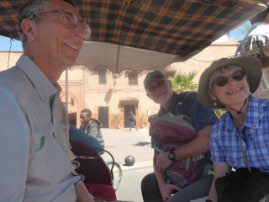
Marrakesh |
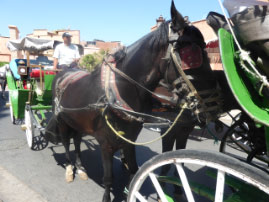
Marrakesh |
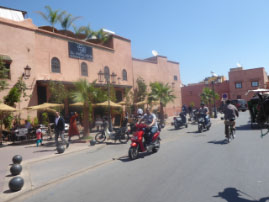
Marrakesh |
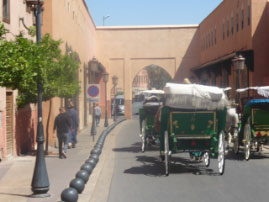
Marrakesh |
Next we visit the Koutoubia Mosque, adjacent to a lovely garden. Its tall minaret is visible for miles in any direction. We often use it to navigate our way back to the hotel when we are on our own – coming back from the market or back from Kozy Bar.
The mosque is the focal point from which the French laid out the road network in their villa nouvelle. In the 12th century, the mosque was constructed and then reconstructed by the Andalusian and lies on the site of a former Almoravid mosque. The Andalusians believed the previous worshippers were heretics, so they had to build this new, "pure" mosque rather than renovate the existing structure. During the construction, someone got the measurements wrong, and the mosque was not correctly oriented toward Mecca. To correct this problem, they built a second, correctly aligned mosque, alongside the original. (The older structure fell into disrepair.)
The Koutoubia Mosque is listed as a must-see in Marrakech, but I found it disappointing. If you’re not a Muslin, you can’t enter the mosque, so we just stand outside looking up at the minaret; necks craned with eyes squinting into the bright sun while our guide carries on.
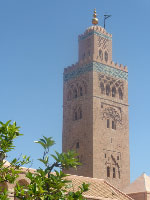
Koutoubia Mosque |
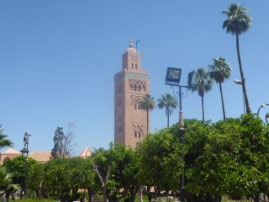
Koutoubia Mosque |
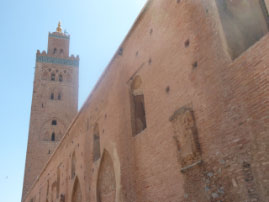
Koutoubia Mosque |
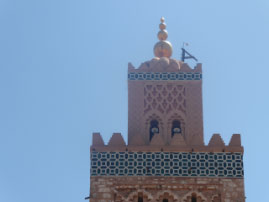
Koutoubia Mosque |
Back in the carriage, we ride through the Gueliz, the modern part of the city built by the French in the early 20th century. It has a certain cosmopolitan buzz that the sleepy old Medina lacks. Its main boulevard, Avenue Mohammed V, contains the city’s main concentration of upscale shops, restaurants, trendy cafés and modern shopping zones. Everything in Ville Nouvelle’s is classy – the gardens, the condos, the hotels – you name it.
Looking back along Avenue Mohammed V from Guéliz to the Medina, the Koutoubia Mosque rises in the distance with the Atlas Mountains behind in the background – beautiful! (Wish I had a picture to show you what I mean!)
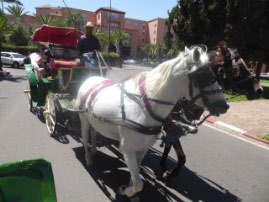
Marrakesh |
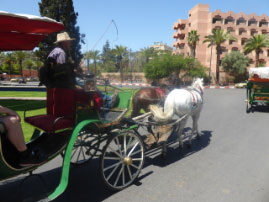
Marrakesh |
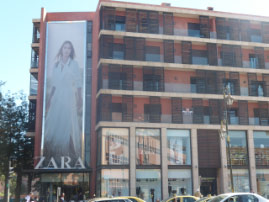
Marrakesh |
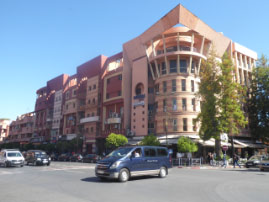
Marrakesh |
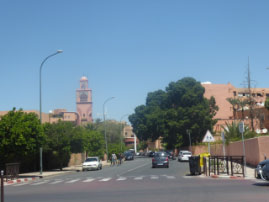
Marrakesh |
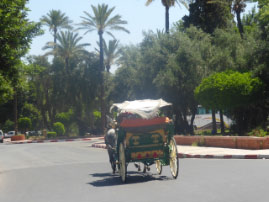
Marrakesh |
We say “good-bye” to our driver and horses at our last stop -- the carpet shop. Bill and I have been through the carpet selling routine lots of times all over the world and know the drill. DO NOT appear the least bit interested. This time is a little different because we are on a mission. Bill needs a new carpet for his office at home. We came armed with the measurements and the maximum we are prepared to pay for a hand woven rug.
During the showing of the rugs, everyone was ooing and ahhing while we remain disinterested. We spot one rug we both like and thought would work. The measurements are right so Bill goes into his heavy bargaining – while I go into don’t really care attitude. (I do have a problem with confrontation – or even the hint of face to face combat.) After 30 minutes of back and forth – the sales guy takes us up stairs to the manager’s office (like buying a damn car). Basically, he gives up and excepts Bill’s last offer – 70% below the listed price. That kind of intense haggling is usually reserved for the market stalls that line the streets, but not here, in this fancy carpet shop. Bill is so good as this.
They swipe the credit card and wrap up our treasure. We bring it home on the plane. It’s in Bill’s office now and we both agree it’s the most beautiful rug we’ve ever seen.
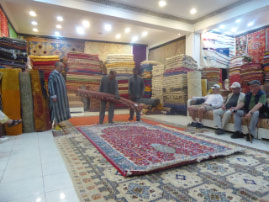
Buying a carpet |
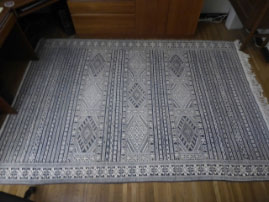
Buying a carpet |
After our carpet haggling, Nour takes us to the grandest of all Berber marketplaces in Morocco. After warning us of the potential pick pocketers again, he leads us through a dizzying concoction of streets and alleys, people and donkeys, carts and motorcycles to a place where most Americans think they must-see -- Snakes dancing to an oboe player. The snakes look hot, tired and sad. The oboe player looks not interested, but does a quick show. His main goal is to collect 10 dirhams from each person wanting to take a picture. I quickly pay my money, but then I’m disappointed in the lighting, the backgrounds, etc. – I do my best to capture the essence of the scene. Just when I’m about to get the photo I want, the oboe player sees someone who didn’t pay and took a picture anyway. This pisses the oboe player / guardian of the snakes off so he grabs a snake and lunges at the cheating guy who didn’t pay his dues. The crowd quickly disperses, screaming and laughing. Wish I had that picture!
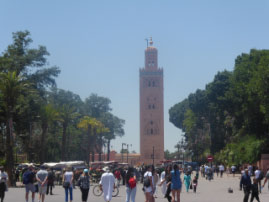
Marrakesh Market |
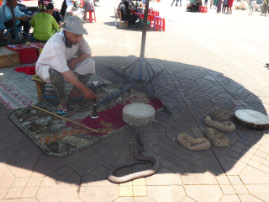
Marrakesh Market |
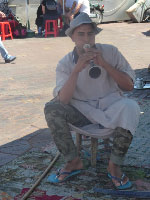
Marrakesh Market |
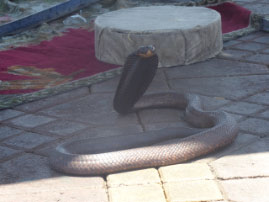
Marrakesh Market |
We meander through market stalls to find a place for lunch. We like hole in the wall places frequented by the locals. Food is fresh and cheap! We sit outside at a table for 4 with 2 strangers. One is a very unpleasant older Belgium woman (ex-pat) accompanied by her aging yapping, spoiled dog. The other is a young with-it Morrocan single guy who is very interested in what we think about his country. It’s probably his job to spy on foreigners. I’m not paranoid or kidding. Every morning, Nour gets a call from somebody in the government asking if anyone in our travel group is suspicious or acting strange. Big Brother really watches you here! Morroco is proud of its clearn slate of no terrorist activities and go to any length to “check on suspicious folks.” I are very safe here … but sad to say that Morroccans don’t know the price of freedom.
At the table, there was some tension between the old Belgium broad and the 007 dude. He is annoyed that her dog is sniffing around the table. He also yells at her to speak English. She ignores 007. Because this is the first Morrocan spoiled brat dog I’ve seen … and because I am lonesome for Molly, our bratty American grand-dog, I openly accept the sniffing dog with some loving pats. The woman’s exterior melts a bit. I can communicate with her now because she answers my questions about her useless dog in English!
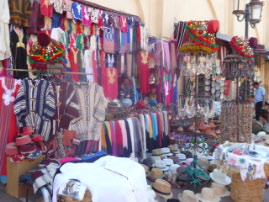
Marrakesh Market |
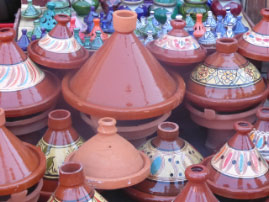
Marrakesh Market |
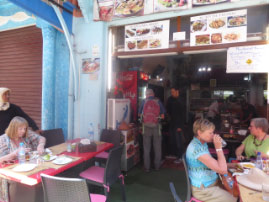
Stopping for lunch |
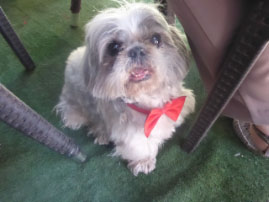
Yappy dog |
It’s been a very full day, interesting day. About midafternoon, we walk back to our hotel for a little R&R in our lovely air conditioned suite.
We link up with Rex and Kathy again later for Happy Hour on the Kozy Bar’s rooftop. Bill consults Trip Advisor to find a place for dinner. The Henna Art Café is listed as #1 where “you can enjoy food, henna, art and classes. All income from these cultural experiences is used to give free education and assistance to Moroccan people.”
The place has a funky, fun feel about it with real heart and soul. We enjoy a light, healthy meal on their lovely rooftop. Nice way to end the day.
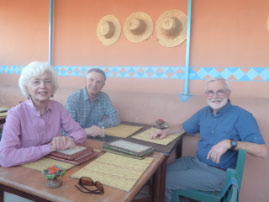
Henna Art Café |
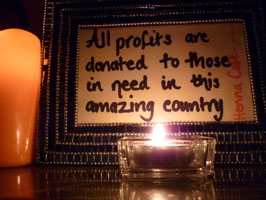
Henna Art Café |
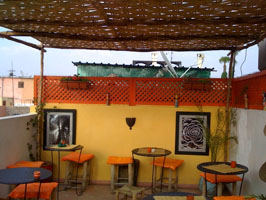
Henna Art Café |
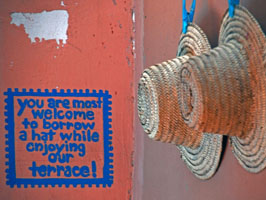
Henna Art Café |
Monday, May 8 – Marrakesh
We have a lot of ground to cover on our last day in Marrakesh. We get an early start at our first stop, Jardin Majorelle.
Jardin Majorelle is a 12 acre botanic garden created in the 1920s and 1930s by French artist Jacques Majorelle (1886–1962), and was later owned by famous designer Yves Saint-Laurent. When Yves Saint Laurent died in 2008, his ashes were scattered in the garden, marked by a memorial to him.
The garden surrounds the original owner’s (Jacques Majorelle’s) art studio. Majorelle had the Art Deco studio painted cobalt blue – the color of French workmen’s overalls, or so he claimed. The combination of eye popping colors along with the selection of plants, water streams, paths, and pools create a magical, space. The background tweets (I mean real tweets) of 15 species of birds add to the peacefulness of the garden. We have about an hour to soak in the tranquility before the crowds descend. (OAT early birds do get the worm.)
We first visit the Berber Museum housed in Majorelle’s art studio and then stroll in the gardens.
The simple museum is beautifully laid out in a series of darken rooms. Spotlights highlight each artifact (or each piece of art). Very effective. Going from room to room, we learn about:
- Berber History (once indigenous people) with info on their culture and language
- Traditional Berber crafts, including textiles, carpet-making and woodwork
- Berber jewelry, all silver because gold is considered unlucky in the Berber tradition.
- Berber traditional dresses and ceremonial costumes from different regions of the country
No photos were allowed, but I did “borrow” one photo from the internet.
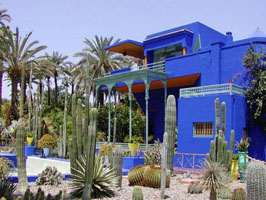
Berber Museum |
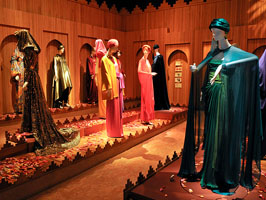
Berber Museum |
After the museum, we stop at the “Gift Shop” with the most beautiful displays I’ve ever seen – along with the most expensive prices! I am attracted to an exhibition of Yves Saint Laurent “Love” poster collages. Every year he created a new poster to send as a New Year’s greetings to his friends. How very sweet!
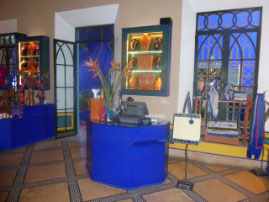
Berber Museum Gift Shop |
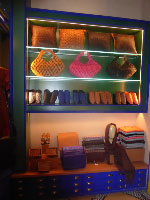
Berber Museum Gift Shop |
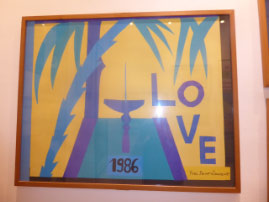
Berber Museum Gift Shop |
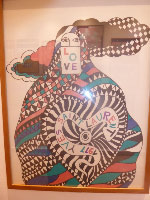
Berber Museum Gift Shop |
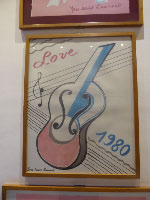
Berber Museum Gift Shop |
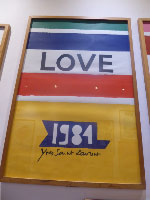
Berber Museum Gift Shop |
We end our “just browsing” mode at the gift shop and start a pleasant stroll through the gardens.
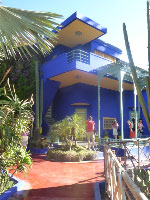
Jardin Majorelle |
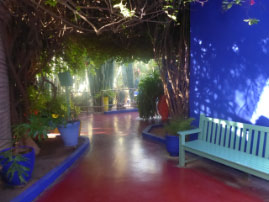
Jardin Majorelle |
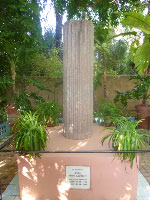
Jardin Majorelle |
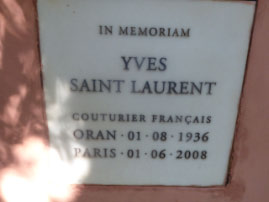
Jardin Majorelle |
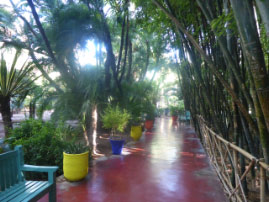
Jardin Majorelle |
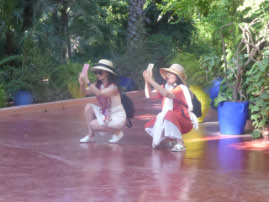
Jardin Majorelle |
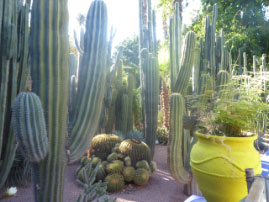
Jardin Majorelle |
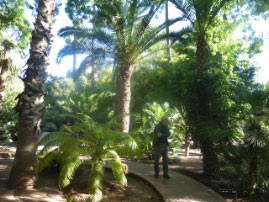
Jardin Majorelle |
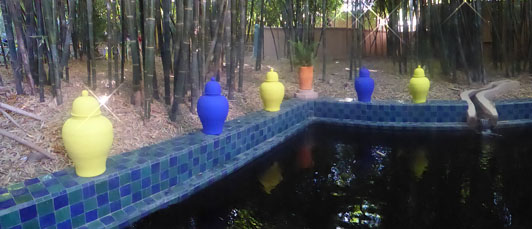
Jardin Majorelle |
We return back to the hotel to regroup. First on our “what’s remaining on Marrakesh must see’s” list is the Photography Museum. Margaret N. (Oakland) wants to see the Photography Museum and joins us. We grab a taxi to one of the gates to the market. From there, we take off on foot (no cars allowed in the market).
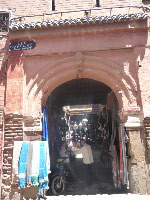
Marrakesh |
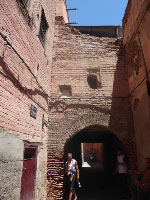
Marrakesh |
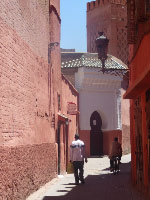
Marrakesh |
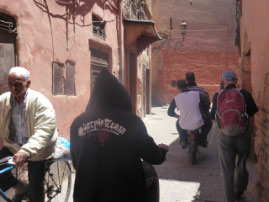
Marrakesh |
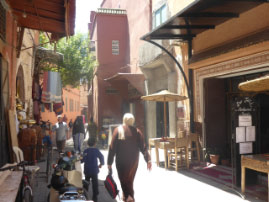
Marrakesh |
Margaret spots clay cooking pots stacked on a shelf at a hole-in-the wall café. She learned that the pots contain a traditional dish that’s not to be missed. The 3 of us squeeze into a little table in the tiny space inside. The staff is thrilled Westerners have come and can’t do enough for us. They adjust the fans to aim directly toward at us (it’s very hot inside) and bring out water and tableware – especially knives and forks.
They serve us chicken and mixed vegetables (I believe) which have been steaming in pots for hours. I swear it is THE BEST MEAL in all of Morocco – and the cheapest. Thank you Margaret for finding this little gem!
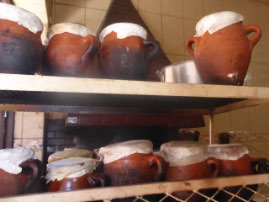
Lunch |
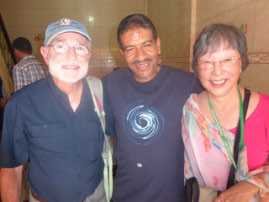
Lunch |
With full tummies, we head to the photography museum. Finding our way through the insane labyrinth of souks is not easy. We take quite a few wrong turns, but never give up. A local wants to help us. He tells us the photography museum is closed and insists we come to his leather shop (I believe) and take a free tour. (He didn’t mention, of course, dropping some money at the gift shop.) He is persistent, but Bill is even more persistent. We keep walking, while he’s pleading. He finally gives up on us and we end up at the photography museum which is OPEN!
The Photography Museum is in the heart of the Medina. It is a delightful converted riad (mansion) run by a Frenchman and his business partner, who started it up when they discovered they had both been collecting historic photographs of ancient Arabs and Berbers.
We pay our entrance fee and climb 3 floors up to start at the roof terrace with a small café. Stuffed from our potted lunch, we’re not interested in the café, but do take in the views of streets below while enjoying the nice breeze.
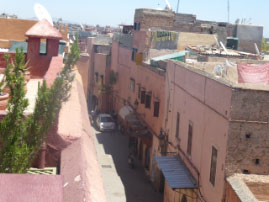
Photography Museum |
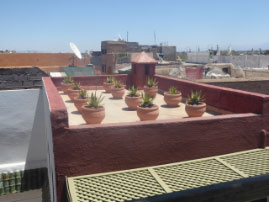
Photography Museum |
We descend down the stairway, stopping at each floor to check out the exhibits. A visit to this quaint little museum is like turning pages of an old scrapbook.
In one room, there is a film, shot in 1957, that looks like one of the very first travel films. A group of Brits (or some other similar European white guys) are taking a 4 day hike in the Berber villages in the High Atlas Mountains. (Note: The “hikers” are seen most of the time riding donkeys in their caravan.)
There are wonderful old black and white photos of Morocco, dating from the 18th to early 20th centuries. I could gaze at the old black and white photographs forever. The clarity of older cameras really capture the moment and offer an insight into the historical development of Moroccan city, country, and mountain life going back more than a hundred years.
It’s interesting that many people I see in the photos could be easily plucked from the photos and dropped down into today’s Morocco and you wouldn’t notice a difference.
The portraits have me mesmerized. I stare at one of the most handsome men -- a cross between George Clooney and Omar Sharif!
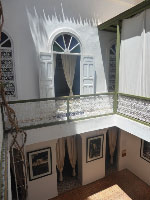
Photography Museum |
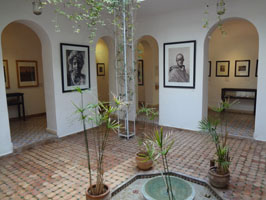
Photography Museum |
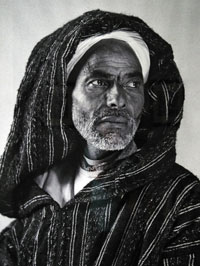
Photography Museum |
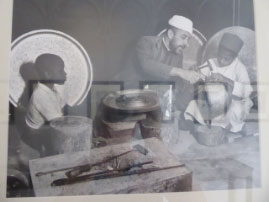
Photography Museum |
After the photography museum, we stumble upon Ben Youssef Madrasa, an Islamic college and the largest educational institution in Morocco. The college, founded in the 14th century, had over 100 small dormitories for the students studying the Koran. Basically, it has been a theological college throughout the 14th century and into the 1960s.
It was hot, we were tired, and the place was crowded, so we didn’t pay the entrance fee to go beyond the main gate and explore. We do get a peek at the main courtyard and pool. The university is centered around this large courtyard with tiny, monk-like dormitory rooms high above. It’s very well preserved and the country’s best example of Islamic architecture with the gorgeous geometric and floral patterns of cedar, stucco, and marble. (No human images allowed in Muslim Land!)
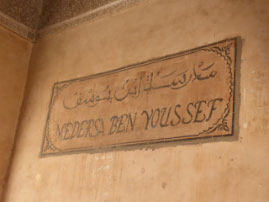
Ben Youssef Madrasa |
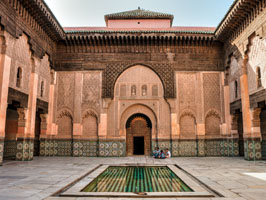
Ben Youssef Madrasa |
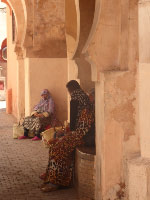
Ben Youssef Madrasa |
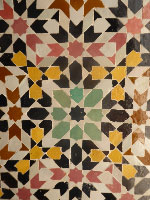
Ben Youssef Madrasa |
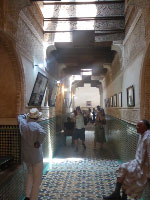
Ben Youssef Madrasa |
Back on the street, we are drawn into the Marrakech Museum, housed in a 19th Century palace. It’s very quiet – no one in sight, including the ticket taker – so we nose around a bit. We are fascinated by some of the contemporary Moroccan art – tile mosaic floating from the ceiling and jewelry displayed like nothing I’ve ever seen before.
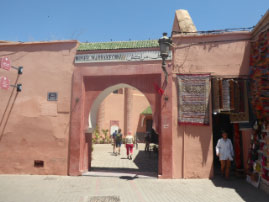
Marrakech Museum |
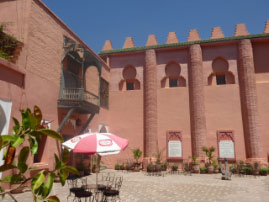
Marrakech Museum |
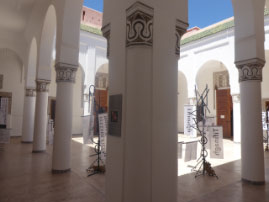
Marrakech Museum |
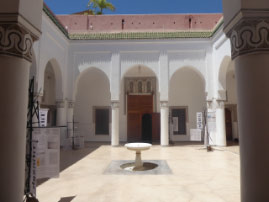
Marrakech Museum |
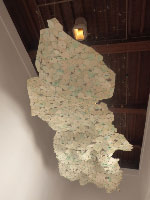
Marrakech Museum |
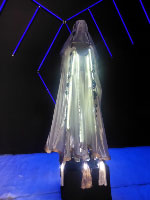
Marrakech Museum |
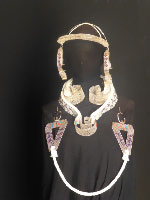
Marrakech Museum |
Back out in the madness of the crammed narrow streets, we dodge speeding motorcycles weaving in between donkey drawn carts and slow tourists and locals. We have several close calls – not easy to keep one’s cool. Of course we get lost again. I’m glad Bill has his GPS to guide us. I am amazed that the GPS actually has this place accurately mapped. Finally, we make our way out of this maze and into the large market square – with familiar landmarks to guide us. We are confident we can make it back to the hotel – and we did!
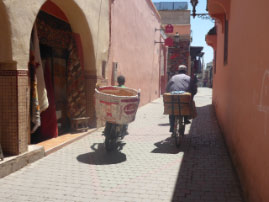
Marrakesh |
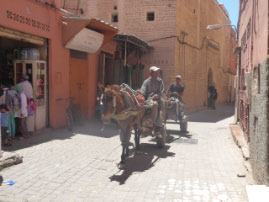
Marrakesh |
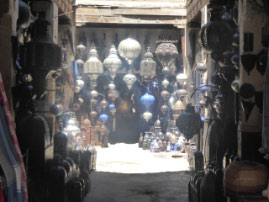
Marrakesh |
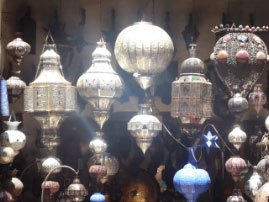
Marrakesh |
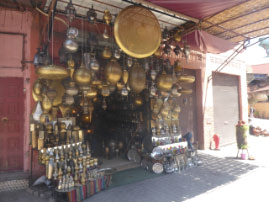
Marrakesh |
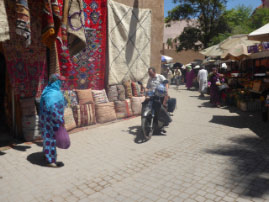
Marrakesh |
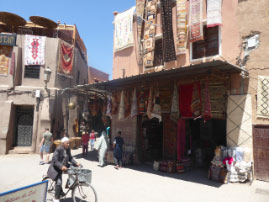
Marrakesh |
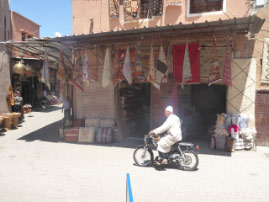
Marrakesh |
Bill and I stop for a cold Casablanca beer at an old hotel near our hotel – a rare hotel that serves alcohol. In lieu of a cold brew, Margaret heads back to her cold, air-conditioned hotel room. Fun afternoon, but still more to come.
When we get back to the hotel, the staff is throwing a fun Moroccan party for us. Moroccans are wild and crazy and know how to have fun (without libations).
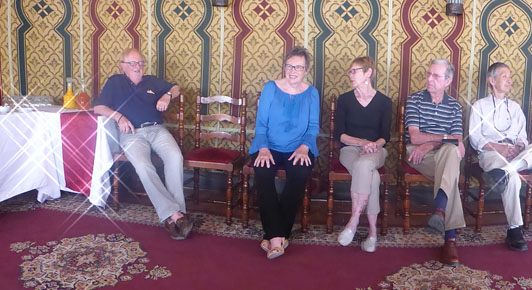
Fun Moroccan party |
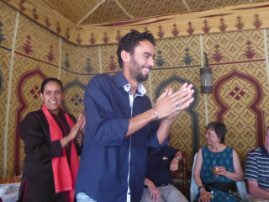
Fun Moroccan party |
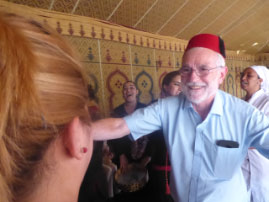
Fun Moroccan party |
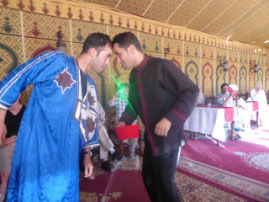
Fun Moroccan party |
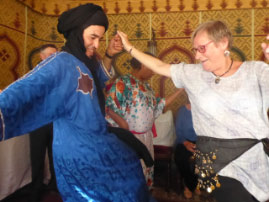
Fun Moroccan party |
After all our dancing and partying, we take the bus to the Red House for our Farewell Dinner. The Red House, once a mansion, is now a beautiful 5 Star Guesthouse with an amazing gourmet restaurant. Can’t say enough about this place -- the food, service and atmosphere are the best we've had in all of Morocco. Beautiful evening – sad to think that the trip will soon be over.
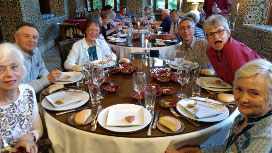
Red House |
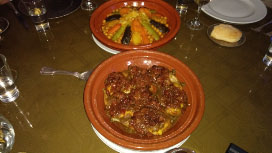
Red House |
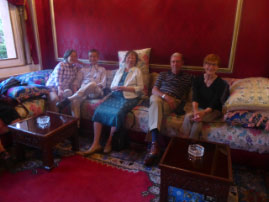
Red House |
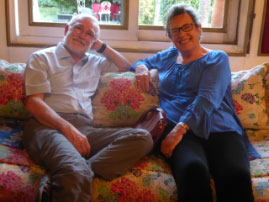
Red House |
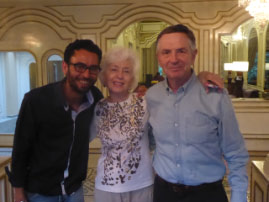
Red House |
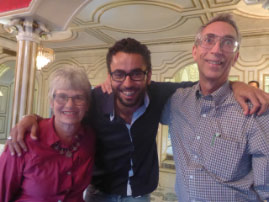
Red House |
Tuesday, May 9 – Marrakesh back to Casablanca
After breakfast we board the bus for Casablanca, about a 150 mile ride. I snap some pictures of our fellow traveling buddies to document the experience – and to trigger a synapse or two when I look at the journal years from now.
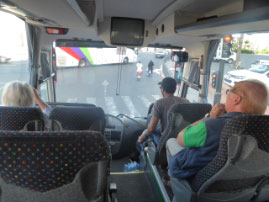
Bus to Casablanca |
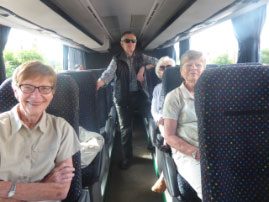
Bus to Casablanca |
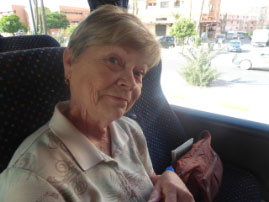
Bus to Casablanca |
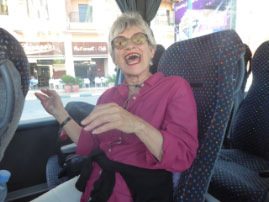
Bus to Casablanca |
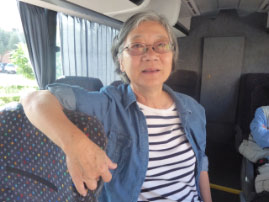
Bus to Casablanca |
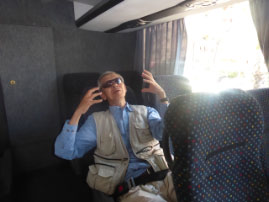
Bus to Casablanca |
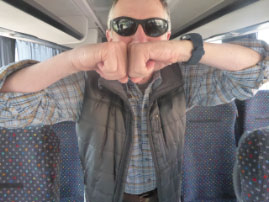
Bus to Casablanca |
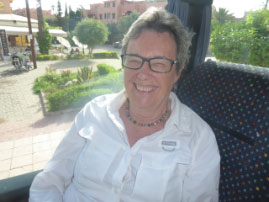
Bus to Casablanca |
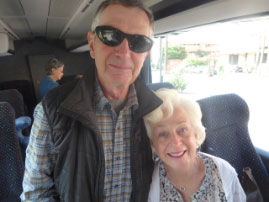
Bus to Casablanca |
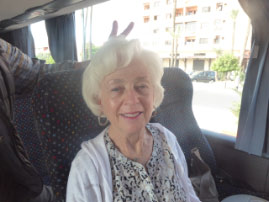
Bus to Casablanca |
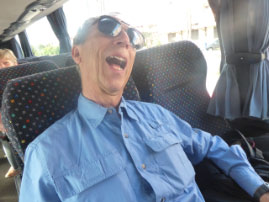
Bus to Casablanca |
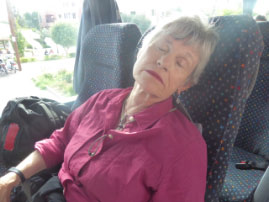
Bus to Casablanca |
We arrive in Casablanca in time for lunch. We drive by the coast and stop at the Terrace Café to eat. It has a great view, but lousy food. Nour warned us – but we chose it anyway.
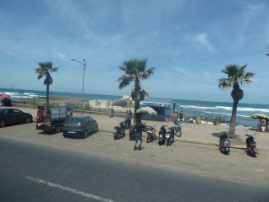
Back in Casablanca |
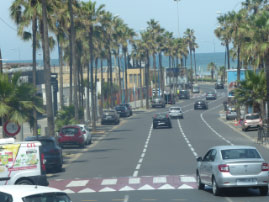
Back in Casablanca |
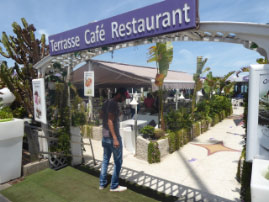
Back in Casablanca |
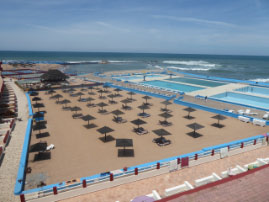
Back in Casablanca |
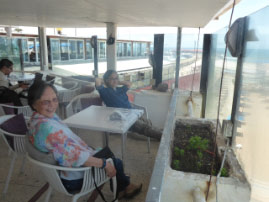
Back in Casablanca |
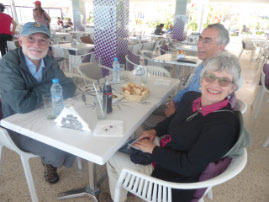
Back in Casablanca |
After lunch, the bus takes us to see the King Hassan II Grand Mosque one more time – even more impressive then when we first saw it 3 weeks ago.
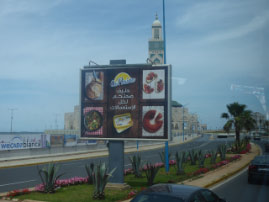
Back in Casablanca |
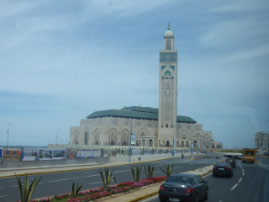
Back in Casablanca |
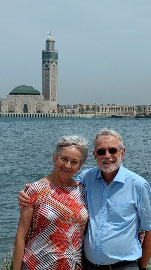
King Hassan II Grand Mosque |
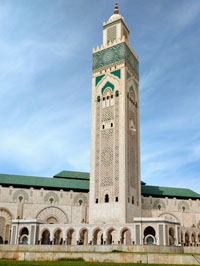
King Hassan II Grand Mosque |
Next, we take a long walk along the Casablanca’s coastline. I expected nice beaches with shaded Palm trees along the road. Instead, I got busy, 4 lane roads with massive commercial centers with accompanying large parking structures lining the beach. The buildings were large and new and modern, but not designed to human scale – They are very pedestrian unfriendly. Where is the zoning when you need it?
I was getting annoyed with the constant traffic that came with the walk. There was a car with four young guys out having fun. They pull up to the curb next to me. They didn’t speak English, so they motion to me that they’d like me in their selfie. I gladly complied and then they went off laughing. They probably don’t see many aging Westerners trying to walk along this beach! In any case, it made my day.
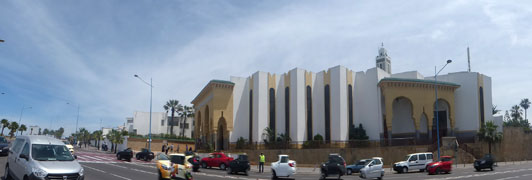
Casablanca’s coastline |

Casablanca’s coastline |
We finish the walk. The bus is waiting to take us back to the Imperial Casablanca Hotel (where we stayed on our first night in Morocco). On the way to the hotel, we make a quick photo stop at Rick’s Café, made famous by the movie, “Casablanca.” People make reservations way WAY in advance and pay big BIG bucks to have dinner and a drink at Rick’s. The truth is that only the exterior was used in the movie. The interior scenes were shot in a café / bar somewhere in Van Nuys in the Los Angeles area. A door man is constantly posted to keep people from parking illegally and from taking mementos off the building.
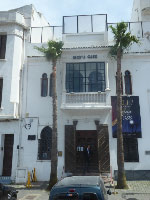
Rick's Cafe |
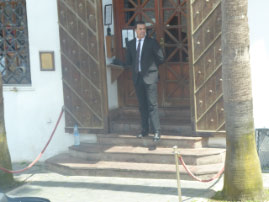
Rick's Cafe |
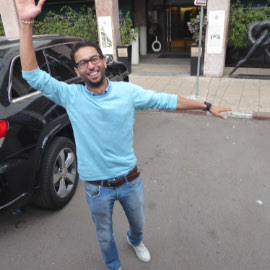
Nour |
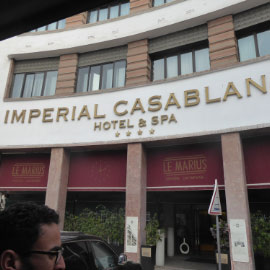
Last night in Morocco |
We check back into the Imperial Casablanca Hotel – feels good to be “home.” I take a few pictures from our window.
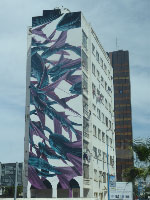
Casablanca |
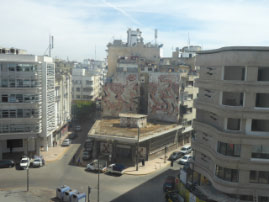
Casablanca |
Later in the afternoon, we take a walk with Nour and some of the gang from the hotel to the heart of the Casablanca. We walk through horseshoe arches with striking facades and decorative tilework. Some of the areas are renovated – while others are in decay.
Casablanca does not have a consistent architectural style. It’s a miss-mash or mix-match, or miss matched collection of styles. Neo-Moorish and Art Nouveau buildings pepper the downtown area -- some fascinating and beautiful while others are in ruin. When the French controlled Morocco in the first half of the 20th century, they added their own unique colonial flair to the local architecture. After Morocco gained its independence in 1956, the styles changed a lot because Casablanca wanted to leave its colonial past behind. Today, some buildings from the colonial era have been beautifully renovated, while others have fallen into disrepair, waiting for restoration to take them back to their former glory.
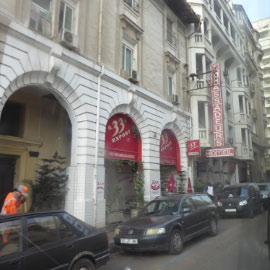
Casablanca |
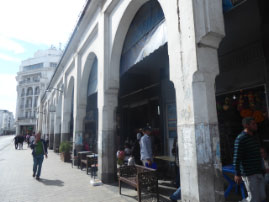
Casablanca |
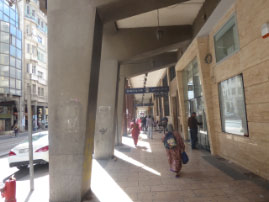
Casablanca |
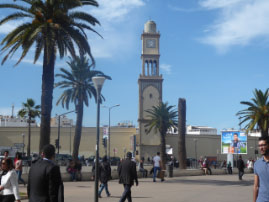
Casablanca |
We arrive in the center of town – can’t miss it. All the side streets culminate into a large open area where the light rail lines meet.
It’s a pedestrian friendly active hub with lots of places to shop or sit outside to enjoy a cup of coffee. Our gang finds a table at an outside coffee shop. Bill and I want to get away from all the hub-bub and have a cold beer. Jerri joins us and we find the perfect place for a beer. Jerri orders white wine. Then, we head back to the hotel.
NOTE: Casablanca’s first light rail line was officially inaugurated by King Mohammed VI in 2012. The entire system was complete just this year in 2017. The 20-mile Y-shaped light rail route has a total of 48 stops with a capacity of 250,000 passengers a day. It is very nice, convenient and inexpensive – less than a dollar a ride, I believe. The Casablancians have given up their cars and life in the big city is so much better. Wish cities in the U.S. had the courage and commitment to do the same.
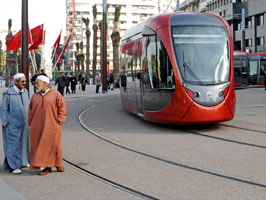
Casablanca |
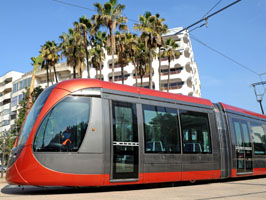
Casablanca |
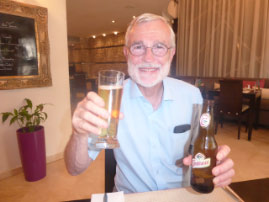
Perfect place for a beer |
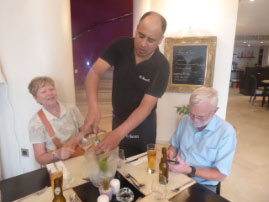
Perfect place for a beer |
Back at the room, we do our final packing – it will be a crazy time tomorrow, getting up at 3 or 4 in the morning. (Such is the life of the weary traveler.)
We have our final dinner together in the hotel. Lovely dinner with new friends that we have come to know and love (except for one). It’s sad that we’ll be scattered around the U.S. with only memories left – and for some of us, memories can be quite fleeting.
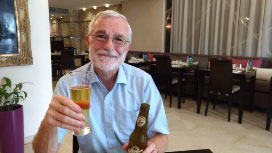
Final dinner together |
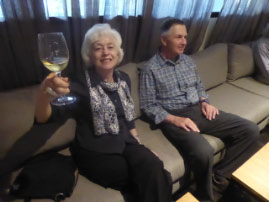
Final dinner together |
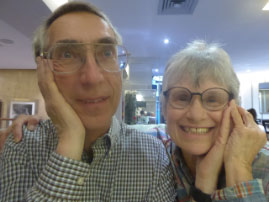
Final dinner together |
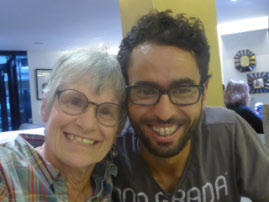
Final dinner together |
Wednesday, May – Casablanca to San Diego
Transit days have their challenges. I put myself on “auto pilot” and let the beautiful memories of a really GREAT TRIP engulf me as our plane takes off and soars over the last views of the King Hassan II Grand Mosque. WOW!
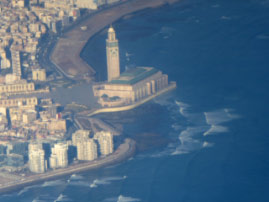
Goodbye Casablanca |
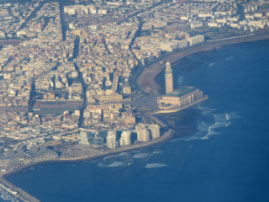
Goodbye Casablanca |
Thank you Nour for making a beautiful trip for us! You touched our hearts!
|











